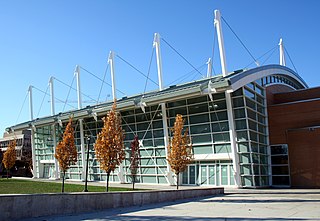
An inspection is, most generally, an organized examination or formal evaluation exercise. In engineering activities inspection involves the measurements, tests, and gauges applied to certain characteristics in regard to an object or activity. The results are usually compared to specified requirements and standards for determining whether the item or activity is in line with these targets, often with a Standard Inspection Procedure in place to ensure consistent checking. Inspections are usually non-destructive.

A building code is a set of rules that specify the standards for construction objects such as buildings and non-building structures. Buildings must conform to the code to obtain planning permission, usually from a local council. The main purpose of building codes is to protect public health, safety and general welfare as they relate to the construction and occupancy of buildings and structures — for example, the building codes in many countries require engineers to consider the effects of soil liquefaction in the design of new buildings. The building code becomes law of a particular jurisdiction when formally enacted by the appropriate governmental or private authority.
An elevator consultant is someone who specializes in the design, testing and maintenance inspection of elevators, escalators, moving walkways and many other conveyances that move people. They are not to be confused with elevator mechanics. Consultants do not normally perform work on conveyances. Some elevator consultants may also work as private elevator inspectors. Some jurisdictions may accept independent third party inspectors for certified inspections while others may employ their own inspectors.

Adaptive reuse refers to the process of reusing an existing building for a purpose other than which it was originally built or designed for. It is also known as recycling and conversion. Adaptive reuse is an effective strategy for optimizing the operational and commercial performance of built assets. Adaptive reuse of buildings can be an attractive alternative to new construction in terms of sustainability and a circular economy. It has prevented thousands of buildings' demolition and has allowed them to become critical components of urban regeneration. Not every old building can qualify for adaptive reuse. Architects, developers, builders and entrepreneurs who wish to become involved in rejuvenating and reconstructing a building must first make sure that the finished product will serve the need of the market, that it will be completely useful for its new purpose, and that it will be competitively priced.

A dropped ceiling is a secondary ceiling, hung below the main (structural) ceiling. It may also be referred to as a drop ceiling, T-bar ceiling, false ceiling, suspended ceiling, grid ceiling, drop in ceiling, drop out ceiling, or ceiling tiles and is a staple of modern construction and architecture in both residential and commercial applications.
The International Code Council (ICC) is a nonprofit standards organization that creates the International Building Code (IBC), a model building code, as well as the International Residential Code (IRC), and other model codes. The IBC has been adopted for use as a base code standard by most jurisdictions in the United States.

Designated as an American National Standard, the Uniform Plumbing Code (UPC) is a model code developed by the International Association of Plumbing and Mechanical Officials (IAPMO) to govern the installation and inspection of plumbing systems as a means of promoting the public's health, safety and welfare.
A structural load or structural action is a force, deformation, or acceleration applied to structural elements. A load causes stress, deformation, and displacement in a structure. Structural analysis, a discipline in engineering, analyzes the effects of loads on structures and structural elements. Excess load may cause structural failure, so this should be considered and controlled during the design of a structure. Particular mechanical structures—such as aircraft, satellites, rockets, space stations, ships, and submarines—are subject to their own particular structural loads and actions. Engineers often evaluate structural loads based upon published regulations, contracts, or specifications. Accepted technical standards are used for acceptance testing and inspection.
To comply with the Building Act 1984 and the subsequent statutory instruments known as the Building Regulations, Building regulations approval is required to construct certain structures in England and Wales. Construction projects falling into this category are sometimes referred to as "notifiable", however this is different from the "notification" (which may also be required under the Construction Regulations 2015, which seeks to monitor health and safety in construction projects.

A home inspection is a limited, non-invasive examination of the condition of a home, often in connection with the sale of that home. Home inspections are usually conducted by a home inspector who has the training and certifications to perform such inspections. The inspector prepares and delivers to the client a written report of findings. In general, home inspectors recommend that potential purchasers join them during their onsite visits to provide context for the comments in their written reports. The client then uses the knowledge gained to make informed decisions about their pending real estate purchase. The home inspector describes the condition of the home at the time of inspection but does not guarantee future condition, efficiency, or life expectancy of systems or components.
Building officials of developed countries are generally the jurisdictional administrator of building and construction codes, engineering calculation supervision, permits, facilities management, and accepted construction procedures.

A building engineer is recognised as being expert in the use of technology for the design, construction, assessment and maintenance of the built environment. Commercial Building Engineers are concerned with the planning, design, construction, operation, renovation, and maintenance of buildings, as well as with their impacts on the surrounding environment.
The Home Energy Rating is an American estimated measurement of a home's energy efficiency based on normalized modified end-use loads (nMEULs). In the United States, the Residential Energy Services Network (RESNET) is responsible for creation and maintenance of the RESNET Mortgage Industry National Home Energy Rating Standards (MINHERS), a proprietary system of standards, which includes standards language for the certification and quality assurance for RESNET Provider organizations. RESNET is an EPA recognized Home Certification Organization (HCO) that also help's create standards in compliance with the American National Standards Institute, namely ANSI 301, ANSI 310, ANSI 380, and ANSI 850. The Building Science Institute, Ltd. Co. (BSI) is another EPA recognized HCO that maintains the ANSI Standards to produce Energy Ratings and compliance with above-code programs such as the ENERGY STAR New Homes Program.
Building services engineering (BSE) is a professional engineering discipline that strives to achieve a safe and comfortable indoor environment while minimizing the environmental impact of a building.

Architectural engineering or architecture engineering, also known as building engineering, is a discipline that deals with the engineering and construction of buildings, such as environmental, structural, mechanical, electrical, computational, embeddable, and other research domains. It is related to Architecture, Mechatronics Engineering, Computer Engineering, Aerospace Engineering, and Civil Engineering, but distinguished from Interior Design and Architectural Design as an art and science of designing infrastructure through these various engineering disciplines, from which properly align with many related surrounding engineering advancements.
Property condition assessments (PCAs) are due diligence projects associated with commercial real estate. Commercial property and building inspections are important for clients seeking to know the condition of a property or real estate they may be purchasing, leasing, financing or simply maintaining. Commercial building inspectors generally follow industry accepted guidelines of ASTM E2018 or the International Standards of Practice for Inspecting Commercial Properties (ComSOP). These commercial inspection standards help both the commercial building inspector and the client to understand the scope agreed to for the inspection, including the systems or areas to be inspected, and is used as a guide to develop said scopes and procedures. Often they are done as part of a property transfer and are done along with a Phase I Environmental Site Assessment. PCAs are not to be confused with facility condition assessments, which are similar in nature but serve a different purpose.
IAPMO R&T was started in 1936 as a third-party listing agency specializing in plumbing and mechanical products. IAPMO R&T is accredited to certify products that meet the criteria of the Uniform Plumbing Code, Uniform Mechanical Code, Uniform Solar Energy Code, Uniform Swimming Pool, Spa and Hot Tub Code and other nationally recognized codes and standards in North America.

The International Plumbing Code is a plumbing code and standard that sets minimum requirements for plumbing systems in their design and function, and which sets out rules for the acceptance of new plumbing-related technologies. It is published by the International Code Council based in Washington, D.C., through the governmental consensus process and updated on a three-year cycle to include the latest advances in technology and safest plumbing practices. The current version of this code is the 2021 edition. The IPC protects public health and safety in buildings for all water and wastewater related design, installation and inspection by providing minimum safeguards for plumbers and people at homes, schools and workplaces. Water heaters, anti-scalding devices, back-flow prevention methods, water pipe sizing and many other such issues are addressed in the IPC.

United States building energy codes are a subset of building codes that set minimum requirements for energy-efficient design and construction for new and renovated buildings. The intent of these energy codes is to moderate and reduce energy use and emissions throughout the lifetime of a building. Energy code provisions may include various aspects of building design and construction, such as: HVAC systems, building envelope, electrical, and lighting systems. There are building energy codes for both commercial and residential buildings. However, just as the United States does not have a national building code, it also does not have a national building energy code; rather, state, and local governments choose to adopt—and potentially revise—national model energy codes and standards. Consequently, building energy codes, and building codes in general, vary between states and jurisdictions.
Geoprofessions is a term coined by the Geoprofessional Business Association to connote various technical disciplines that involve engineering, earth and environmental services applied to below-ground ("subsurface"), ground-surface, and ground-surface-connected conditions, structures, or formations. The principal disciplines include, as major categories:








